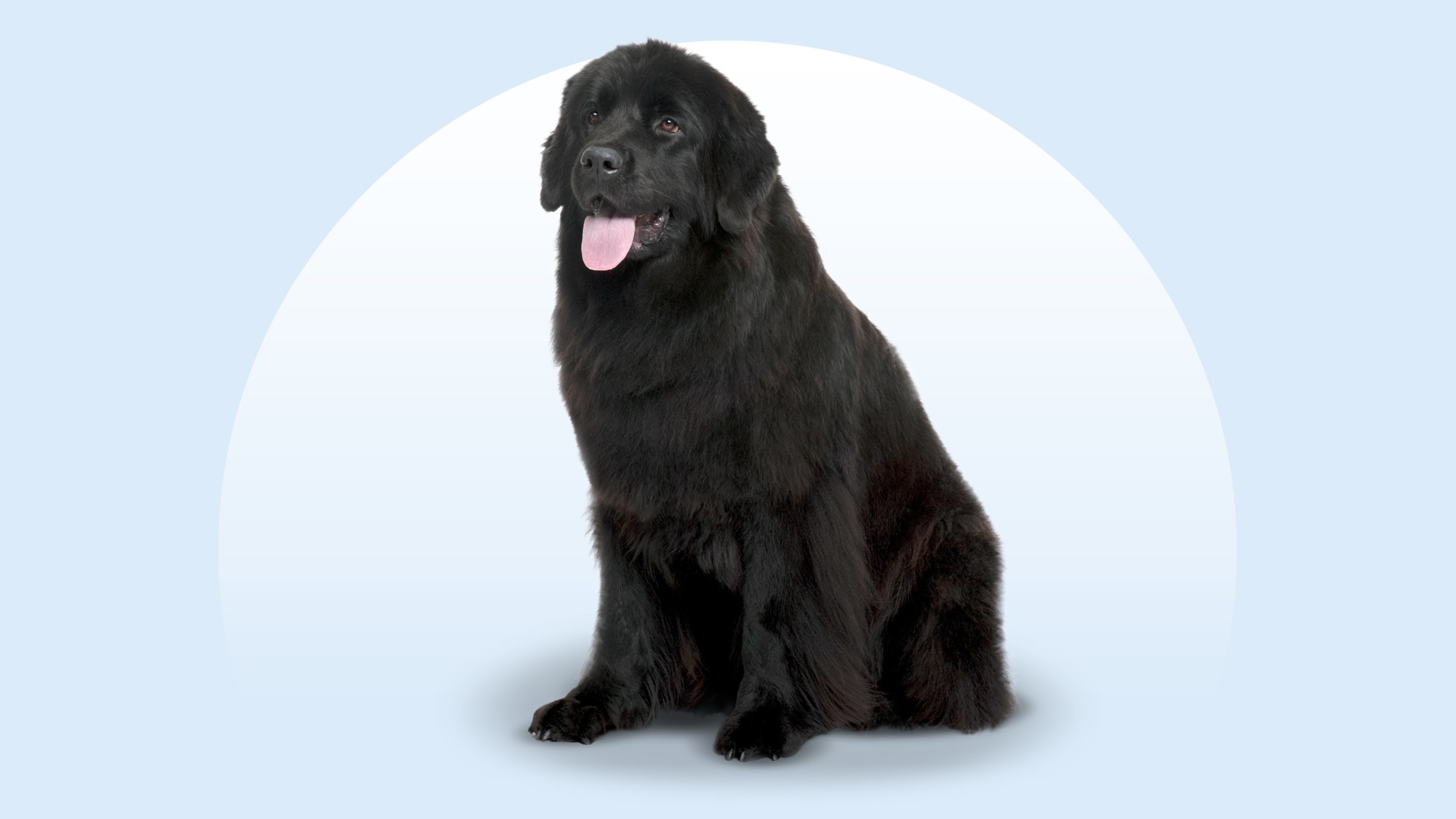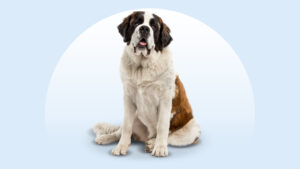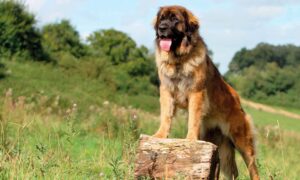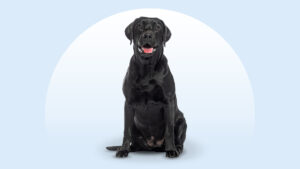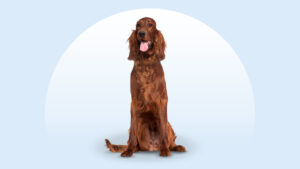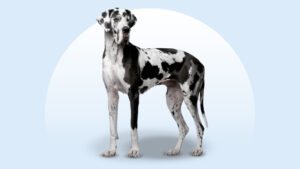Newfoundland
Updated May 5, 2025
Newfoundland
Updated May 5, 2025
A little silly, super friendly, and exceptionally sweet, the big Newfoundland is the perfect family dog who will probably get along with anyone (even if they tower over all the kids and other pets at home).
Charming, Friendly, Patient
100–150 pounds
26–28 inches
9–10 years
Black, White and Black, Brown, Gray
This water-loving pup will probably weigh more than your child—and maybe even you—but don’t let that intimidate you. Newfoundland dogs are big softies, literally and figuratively.
Newfoundlands adore the outdoors, and they arguably love water more than fish do, so expect to come home with a very wet (and possibly muddy) pup. It’s all worth it to see these huge canine kiddos live out their mermaid dreams.
And if you haven’t gotten around to meeting your neighbors yet, just take your Newfie on a walk—this friendly dog will be delighted to introduce you to everyone in your path.
Newfoundland Characteristics
Newfoundland Appearance
Full-grown Newfoundlands typically weigh at least 100 pounds. With a dense, heavy coat, Newfies carry their head proudly, and their tail hangs straight when they’re relaxed.
Most of the time, Newfoundland dogs have coats that are black or black and white, but they also come in brown and gray.
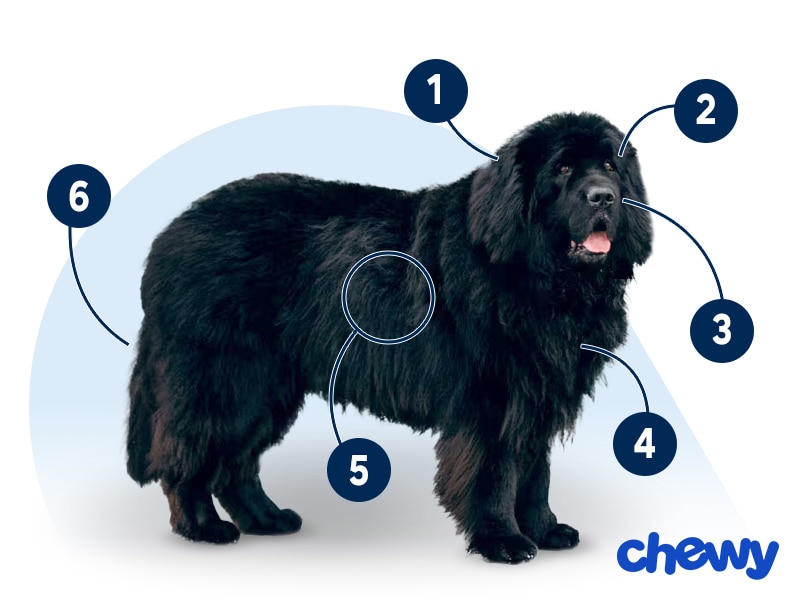
- Ears
Their ears are relatively small and triangle-shaped with rounded tips.
- Eyes
Newfie eyes are dark brown and relatively small; they’re deep-set and spaced widely apart.
- Nose
Their noses can be black or brown.
- Coat Length
A Newfoundland has a flat, water-resistant double coat, with a soft undercoat and coarse outercoat.
- Coat Color
Their coats can be black, brown, gray, or black and white.
- Tail
Newfie tails are broad at the base and hang straight or with a slight curve at the end. They’re covered with long, dense hair.
Newfoundland Temperament
Newfoundlands are known for their patient and gentle demeanor. They love being with their people and are naturally friendly with strangers.
Just like all dogs, Newfoundland puppies need early socialization (or as early as possible, depending on what age you bring them home). Exposure to new people, places, and things will help them take on the world without fear.
Socialization will also teach them how to play with other pups—your Newfie will probably not understand how big they are, and someone’s got to tell them! Consistent training will help your Newfoundland grow up to be a confident, well-adjusted dog. And because they’re quite bright, your Newfie will probably pick up cues quickly.
The sweet-tempered Newfoundland makes a great family dog, as they typically get along well with kids of all ages, even the littlest babies and toddlers. Unfortunately, young ones sometimes mistake a Newfoundland for a pony and think they can ride them, so teach kids that dogs prefer pets, not rides. (This kind of behavior can also aggravate health problems like hip dysplasia, so it’s important to avoid it.)
In general, though, these gentle giants make any home a happier place.
How to Care for a Newfoundland
Newfoundlands need a lot of love and care. What else would you expect from a dog the size of a teenager? They shed a lot and drool a lot, so grooming is key. However, while they will definitely enjoy hanging out with you, they don’t need a ton of exercise.
Grooming
Training
Diet
Exercise
Environment
Newfoundland Health
The average Newfoundland dog lifespan is 9–10 years, as large dogs sadly don’t live as long as smaller pups. Here are some health issues to be aware of:
- Bloat and gastric dilatation-volvulus (GDV): Newfoundlands, like many large breeds, are prone to a life-threatening condition called gastric dilatation-volvulus, a severe form of bloat. It occurs when the stomach gets distended with air and/or food and twists, cutting off blood supply to the organs. Symptoms include abdominal distension, restlessness, and dry heaving. If you notice these signs, go to the vet immediately.
- To reduce the chances of GDV, use a slow feeder and offer your dog smaller meals throughout the day instead of one big dinner. Keep their food bowls on the ground (don’t elevate them) and don’t exercise one hour before or after meals. A preventative gastropexy procedure might be a good idea, too.
- Elbow and hip dysplasia: Elbow and hip dysplasia are genetic conditions that develop during puppyhood when the joints don’t align well and become looser than normal. Signs include limping, and treatment might involve weight loss, reduced activity, joint supplements, physical therapy, pain meds, or, in severe cases, surgery.
- Heart disease: Dilated cardiomyopathy (DCM), or an enlarged heart, is one of the most common heart diseases in large-breed dogs. When the heart enlarges, it results in thin and weakened heart muscles that can lead to heart failure.
- Cystinuria: Cystinuria is a genetic disorder that causes an amino acid called cystine to form in the urine, leading to kidney and bladder stones. Symptoms include straining to urinate, peeing frequently in small amounts, having accidents at home, and blood in the urine. This is a medical emergency, and treatment may involve diet changes, medicine, and/or surgery, depending on severity.
Newfoundland History
Fishermen relied on these dogs because of their partially webbed feet and natural swimming abilities; they assisted in water rescues and hauled fishing nets ashore. The breed was recognized by the American Kennel Club in 1886.
Today, the dog appears on 10 different monuments across the U.S., and it’s easy to see why: In 1802, Lewis and Clark took a Newfoundland named Seaman on their famous expedition. Multiple presidents have had Newfies, including James Buchanan, Ulysses S. Grant, and Lyndon B. Johnson. Senator Robert F. Kennedy even had a black Newfoundland dog named Brumus, whom he took to work with him.
A Newfoundland puppy can cost up to $3,000. If you choose this route, pick a responsible breeder.
You can also go the route of Newfoundland adoption. Look for a Newfoundland dog rescue, such as the National Newfoundland Rescue; keep an eye out for the breed at your local animal shelter; or search Chewy’s database of adoptable dogs in your area.
